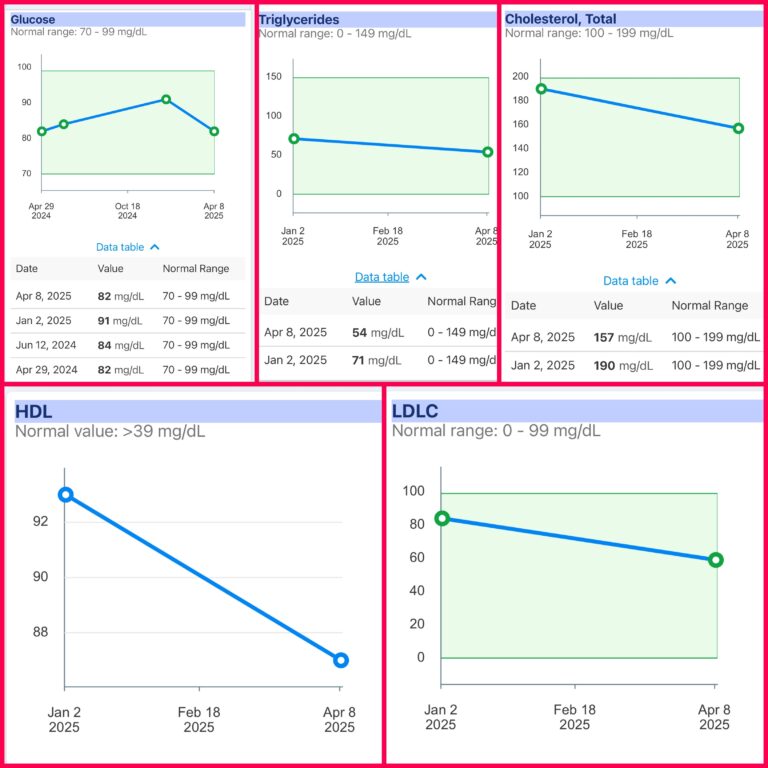
Y’hello Beastie!
Let me tell you how a routine blood test almost knocked me off my chair.
I mean, here I am—fitness coach, nutrition nerd, 4 AM gym warrior—and bam: prediabetic. Yep. That was my wake-up call.
At first, I was confused. I don’t eat a ton of sugar. I train like a beast. But as it turns out, prediabetes doesn’t always care if you’re fit on the outside. It cares about what’s happening on the inside—your insulin sensitivity, your cellular health, your recovery, your stress. And apparently, mine needed a little TLC (tender loving care).
And here’s where it gets even more personal: diabetes runs on both sides of my family. I’ve lost family members to it. So while I’m not afraid of dying… I sure as hell don’t want to die from something I can prevent. That’s what made this different. This wasn’t just about fitness anymore. It was about breaking a cycle.
The Plan That Changed Everything
Instead of spiraling, I pulled a classic Lola K move: I got strategic. I crafted a 12-week plan just like I would for one of my own clients—with structured nutrition, targeted training, and full lifestyle support.
- High-protein, low-carb meals to regulate blood sugar.
- Strength training + low-impact cardio to burn fat and improve insulin sensitivity.
- A flexible, realistic system I could actually stick to, because let’s be honest, burnout doesn’t look good on anyone.
I treated myself like a client—because sometimes the best coaching starts from within.
Why High-Protein, Low-Carb Changed the Game
Let’s talk food. Not the fad stuff—the science-backed, blood sugar-loving kind.
A high-protein, low-carb diet works wonders for managing prediabetes and even reversing it in some cases. Why? Because carbs—especially refined ones—break down into glucose, which spikes blood sugar. In someone with insulin resistance, those spikes hit harder and stick around longer.
By cutting back on carbs and emphasizing protein, here’s what happens:
- Fewer blood sugar spikes, which means less strain on your insulin system.
- More satiety, so you’re fuller longer and less likely to snack on sugary stuff.
- Muscle preservation, which is key when you’re trying to lose fat but not lose strength.

Protein is basically your hormonal wingman—it helps regulate appetite, supports stable energy, and keeps metabolism humming. In my case, it helped my glucose levels stabilize and made my meals feel like fuel instead of landmines.
One product that’s been a total game-changer for me during this process? MuscleTech Nitro-Tech Ripped. It’s a high-quality whey protein that not only helps build lean muscle, but it’s also designed to support fat loss—with ingredients like L-carnitine and CLA. I used it post-workout and in my smoothies, and honestly? It made hitting my protein targets so much easier without adding fluff to my macros. It’s part of why I leaned out and gained visible definition at the same time.
And don’t worry—I still eat carbs. Just smart ones. Controlled portions. Timed with intention. I don’t do deprivation—I do strategy.
Precision Tracking with a Purpose

Now, I didn’t just hope my diet was on point—I tracked it. Every gram. Every macro. Every plate.
I used MyFitnessPal to log my meals and make sure my macronutrients aligned with the exact ratios I calculated for my goals—as a certified nutrition coach. No guesswork. Just strategy.
On most days, my macro breakdown looked like this:
- Protein: 43% (141g)
- Fat: 44% (65g)
- Carbs: 13% (44g)
That high-protein, low-carb structure kept my blood sugar stable, my energy consistent, and my hunger quiet. And yes, I still had room to enjoy my food—I just made my plate work for me, not against me.
Tracking may not be sexy, but it’s powerful. Especially when your health is on the line.
Exercise: The Glucose Whisperer
Now let’s move.
Exercise—especially strength training and cardio—is like medicine for prediabetes. And no, I’m not just saying that because I’m a personal trainer. I’m saying it because it’s backed by data and lived experience.
Here’s what happens when you move:
- Muscles become more insulin-sensitive, meaning they soak up glucose for energy, without needing as much insulin.
- Strength training builds lean muscle, which burns more calories even at rest and acts like a sponge for excess blood sugar.
- Cardio helps lower overall glucose levels and improves cardiovascular health (because heart health and blood sugar go hand-in-hand).
When I started training more consistently—lifting with purpose and walking briskly at least 3 miles a day—I felt it. My energy became steadier. My cravings less intense. And the data followed: glucose dropped, body fat went down, and I felt more me again.
The key? Consistency over intensity. You don’t need to kill yourself in the gym. You just need to train smart, train often, and train mean.
What the Scale Didn’t Tell Me
Did I hit my 20-lb weight loss goal? Not quite. The scale dropped 12 lbs, but here’s the juicy part:
- My body fat dropped to 21.1%.
- I’m stronger than ever.
- Muscle definition? Baby, it’s giving.
- And my bloodwork? Oh honey—let’s talk about that.
The Blood Work Breakdown
Let me hit you with the receipts:
- Glucose: 82 (normal range: 70–99 mg/dL).
- Cholesterol: Total 157 | HDL (the good stuff) 87 | LDL 59.
- Triglycerides: 54.
- Liver + Kidney function: Normal and thriving.
- Electrolytes, proteins, enzymes: All in beautiful harmony.
These numbers scream improvement. Lower inflammation, better cardiovascular health, and my insulin resistance is clearly shifting in the right direction.
Except for one stubborn little thing…

That Pesky A1C
My A1C stayed at 5.7—still technically in the prediabetic range.
Here’s the thing: A1C reflects your average blood sugar over the past 3 months. And guess what? At the start of that 3-month window, I hadn’t fully implemented my new habits yet. So part of that average includes my “Before Beast Mode” numbers.
Also? A1C isn’t the most sensitive test. It doesn’t reflect daily fluctuations or short-term wins. That’s why you can have:
- Normal glucose levels (like my 82),
- But still carry a prediabetic A1C.
Especially if your cells are still adjusting or your insulin response hasn’t fully normalized yet.
Translation: I’m healing—but we’re not done yet.
So What’s Next?
You guessed it: I’m diving into Round 2. Another 12-week plan, more tailored than ever. This one’s laser-focused on:
- Reducing that A1C.
- Building lean muscle.
- And keeping blood sugar stable, steady, and boring—in the best way possible.
I’ll be tracking everything—meals, workouts, glucose, mindset—and yes, I’ll be documenting it all so you can follow along.
Wanna Join Me?
I coach people just like you—busy, stressed, maybe a little discouraged. Whether you’re facing prediabetes, are diabetic, want to lose weight, or just need a structure that works, I got you.
Check out my coaching services here.
And if you’re hungry for healthy recipes that don’t taste like cardboard, grab my ebooks here.
Everything I used in my transformation is what I give my clients—this isn’t theory. It’s real, tested, lived-through experience.
Let’s Stay Connected
Want to see the real-time version of this journey? I share meal prep videos, motivational nuggets, and fitness tips regularly on my socials:
- Facebook: Beasts Train Mean on Facebook
- Instagram: @beaststrainmean
I’m right there with you, Beastie—showing up, doing the work, and living proof that change is possible.
Let’s Beast It—Together
This isn’t the end of the story. It’s the middle, and I want you with me for the ride. I’ll be posting updates, sharing behind-the-scenes pics, and telling the truth about what it’s like to heal your body from the inside out.
So stay tuned, Beastie. The best is still loading.
Train mean.

